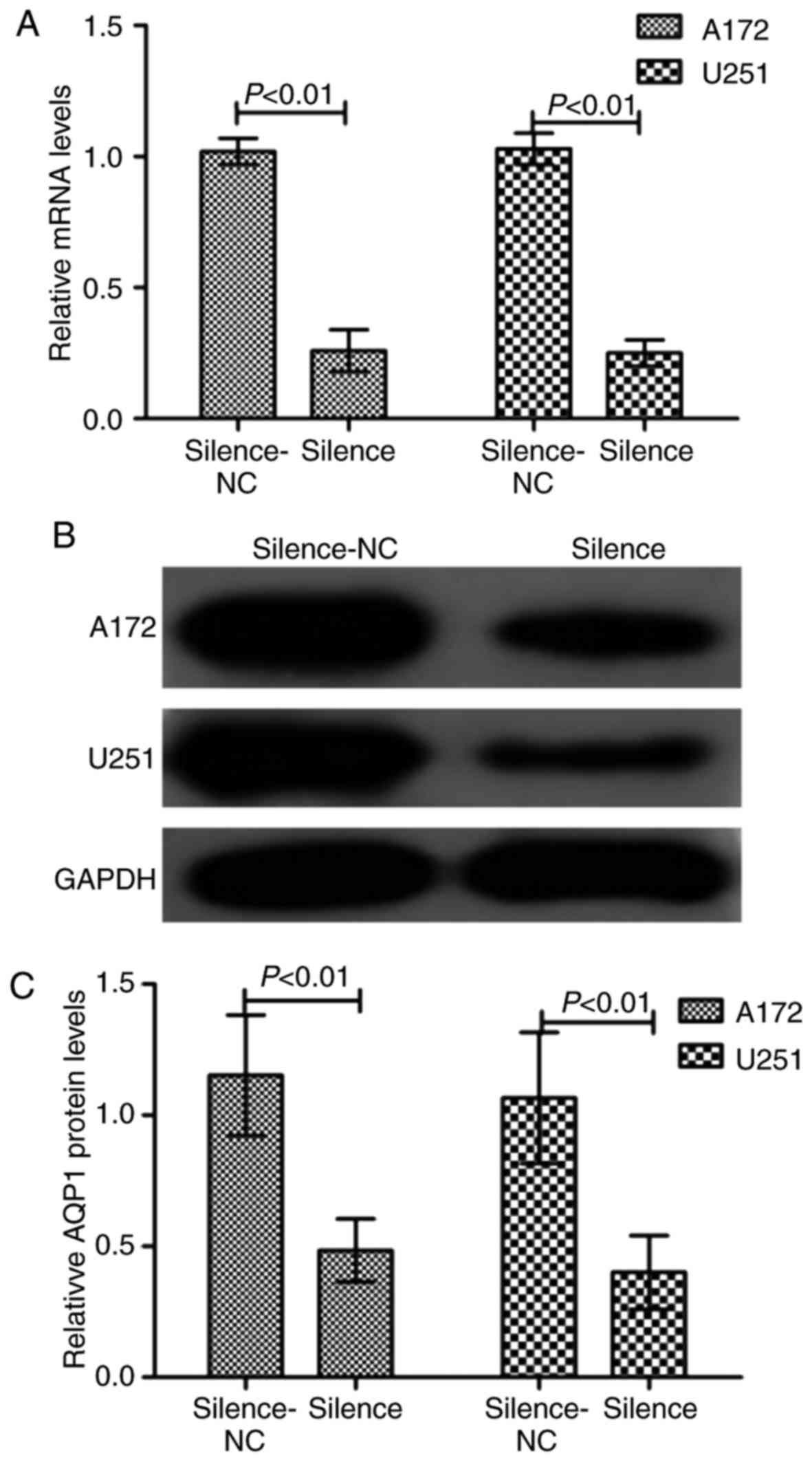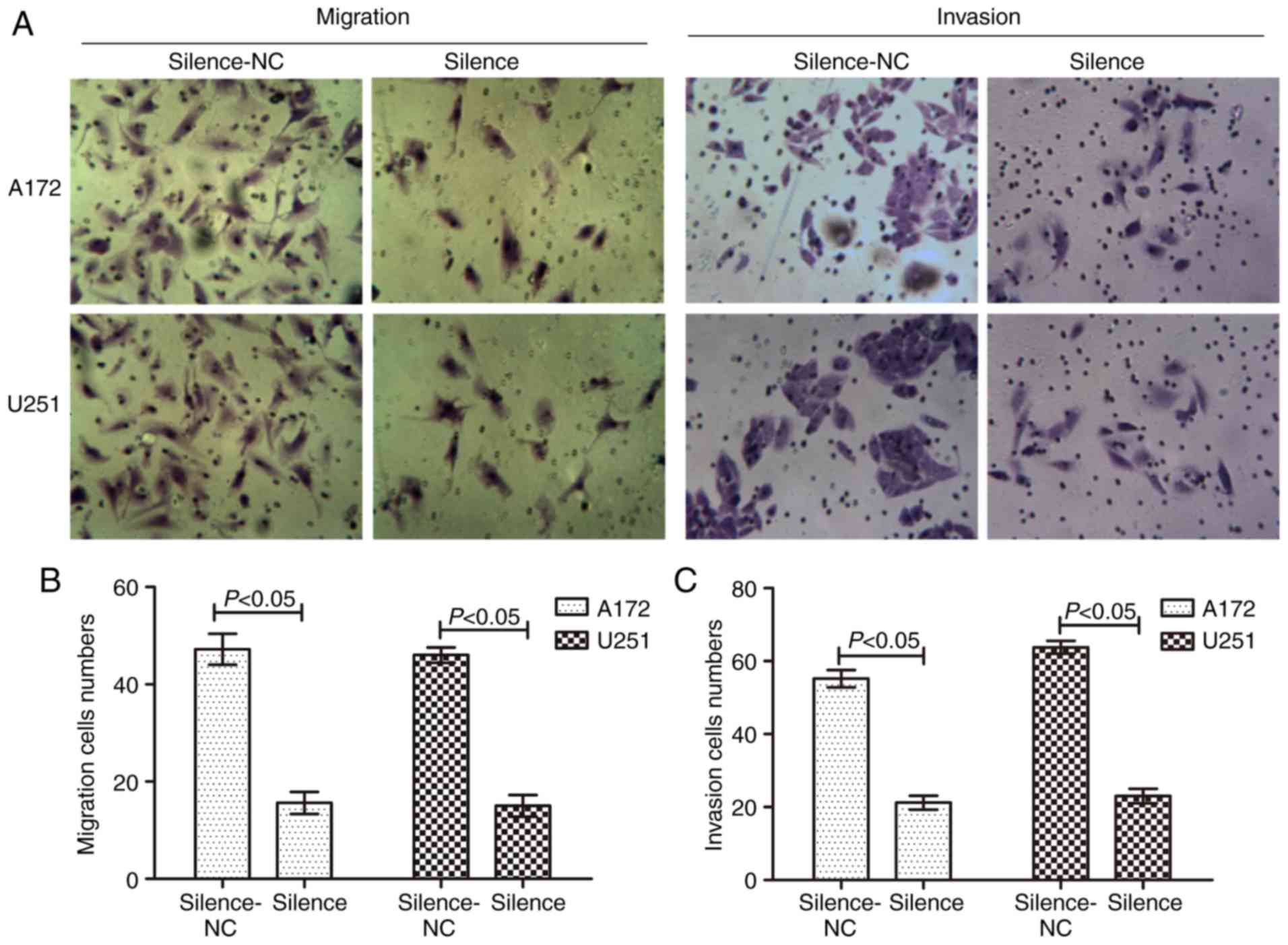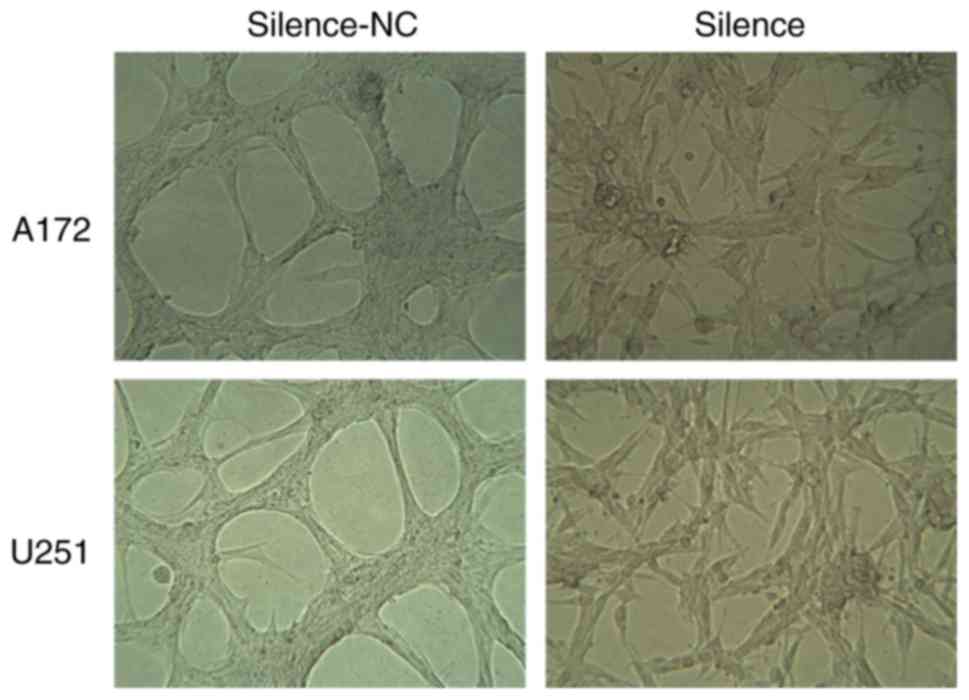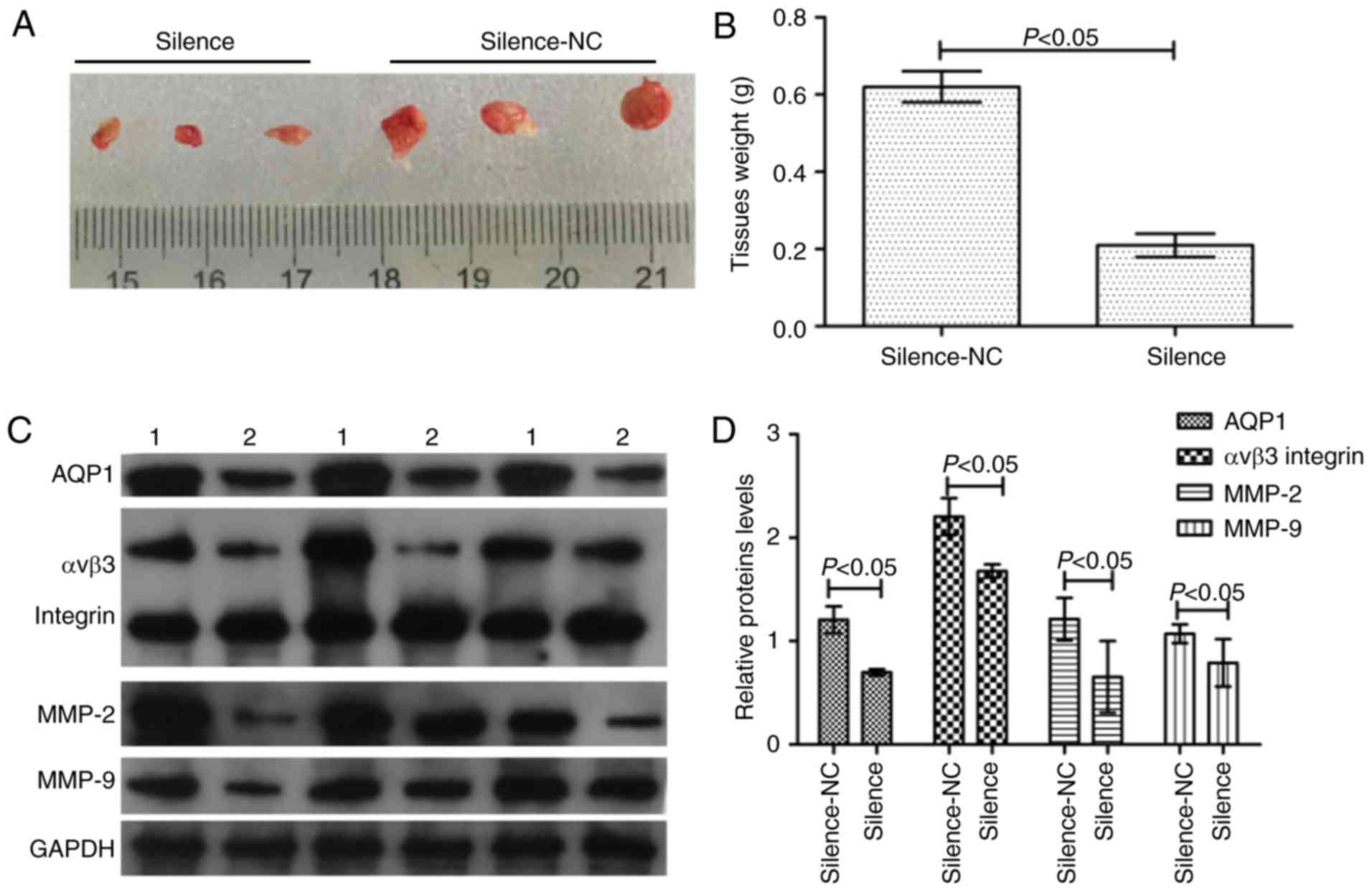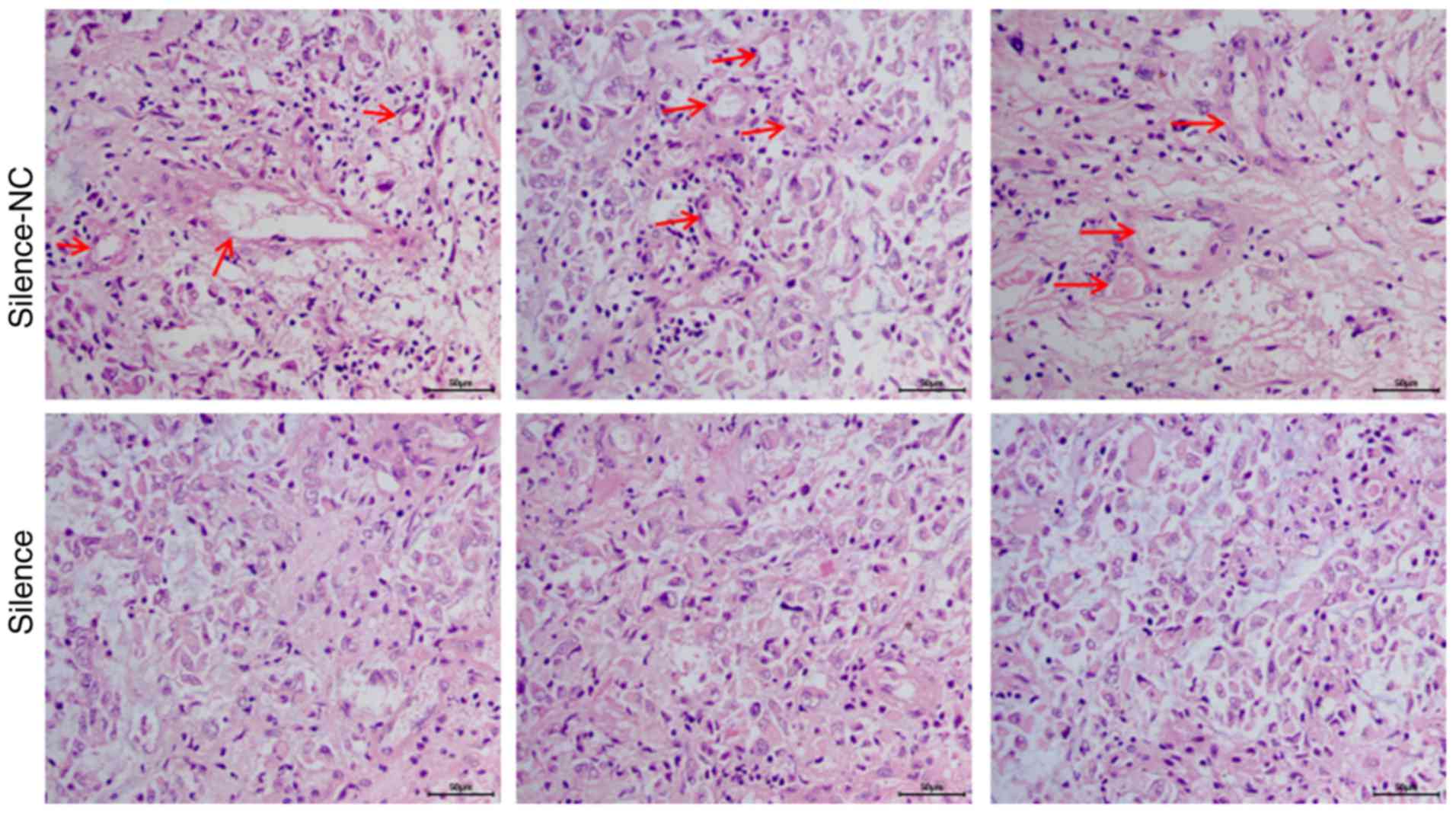Association of aquaporin‑1 with tumor migration, invasion and vasculogenic mimicry in glioblastoma multiforme
- Authors:
- Published online on: December 12, 2017 https://doi.org/10.3892/mmr.2017.8265
- Pages: 3206-3211
Abstract
Introduction
Glioma is the most common malignant tumor of the central nervous system in adults. According to the WHO classification of tumors of the nervous system, glioma may be further divided into four grades (grades I–IV) with increasing malignancy (1). Grade IV, additionally termed glioblastoma multiforme (GBM), is the most malignant type of brain tumor. Despite the improved survival associated with modern surgical, chemotherapy and radiotherapy treatments, the prognosis of patients with glioma remains poor due its rapid and invasive growth, its genetic heterogeneity, and a lack of understanding of its underlying molecular mechanisms (2,3).
Vasculogenic mimicry (VM) refers to non-endothelial tumor cell-lined microvascular channels in aggressive, malignant and genetically dysregulated tumors (4,5). A previous report indicated that VM had been implicated in invasion, metastasis and cancer progression (6). However, there is limited data regarding the correlation with VM and abnormally-expressed genes in human gliomas. Aquaporins (AQPs) are a family of water-selective transmembrane transport channels that allow rapid movement of H2O across normally hydrophobic cell membranes (7). In previous studies, AQP1 and AQP4 have received the most attention due to their contributions to brain edema (8,9). In brain tumors, studies have demonstrated that AQP1 expression is increased with the grade of malignancy, and was associated with tumor blood vessels (10,11). However, the role of AQP1 remains speculative in glioma.
In the present study, the AQP1 expression was measured in clinical glioma tissue samples and GBM cell lines. Subsequently, short hairpin (shRNA)-mediated AQP1 silencing was used to assess the potential effects of AQP1 on migration, invasion and VM formation using two types of GBM cell lines in vitro and in vivo. The present study aimed to assess the expression and functional role of aquaporin-1 (AQP1) in human GBM migration, invasion and VM formation.
Materials and methods
Clinical samples and cell lines
All the clinical glioma tissues samples were obtained from Guangzhou Overseas Chinese Hospital (Guangzhou, China) and, according to criteria from the World Health Organization (WHO), classified into 4 grades with increasing malignancy: Grade I pilocytic astrocytoma; grade II astrocytoma; grade III anaplastic astrocytoma; and grade IV GBM, the most malignant brain tumor. For each grade, 10 cases were used in the present study. All samples were freshly frozen in liquid nitrogen and stored at −80°C until RNA extraction. The present study was approved by the Institutional Review Boards of the Guangzhou Overseas Chinese Hospital, and all participants provided written informed consent. The GBM cell lines A172 and U251, and the normal glial cell line HEB were obtained from the Shanghai Cell Collection (Shanghai, China). The cells were cultured in Dulbecco's modified Eagle's medium (Hyclone; GE Healthcare Life Sciences, Logan, UT, USA) supplemented with 10% fetal bovine serum (Hyclone; GE Healthcare Life Sciences) at 37°C in a 5% CO2 humidified atmosphere.
Cell transfection
The shRNA-AQP1 was synthesized and cloned into the pSUPER-retro-puromycin plasmid (Shangahi GenePharma Co., Ltd., Shanghai, China). The shRNA-AQP1 sequence was: 5′-GATCACACACAACTTCAGCAACTCGAGTTGCTGAAGTTGTGTGTGATC-3, and the negative control sequence was: 5′-CACCGTTCTCCGAACGTGTCACGTCGAAACGTGACACGTTCGGAGAA-3′. The plasmids above were combined with PIK vector, and lentiviral vectors were constructed. Following 10 h transfection (multiplicity of infection=20) using Lipofectamine 2000 (Invitrogen; Thermo Fisher Scientific, Inc. Waltham, MA, USA), according to the manufacturer's protocol, the transfected A172 and U251 cells were selected with puromycin, and the stably transfected cell lines were prepared by monoclonal screening. Reverse transcription-quantitative polymerase chain reaction (RT-qPCR) and western blot analyses were used to assess the transfection efficiency as detailed below.
RT-qPCR assay
Total RNA was extracted from the tissues and cells using TRIzol reagent (Invitrogen; Thermo Fisher Scientific, Inc.). The cDNA synthesis kit (Takara Biotechnology Co., Ltd., Dalian, China) was used, according to the manufacturer's protocol. qPCR was performed to detect the expression levels of AQP1 mRNA using the LightCycler 480 detection system (Roche Diagnostics, Indianapolis, IN, USA). The thermocycling conditions were as follows: Initial denaturation at 95°C for 3 min, followed by 45 cycles of 95°C (15 sec) and 60°C (30 sec). The primer sequences of AQP1 were: Forward, 5′-TCATCTACGACTTCATCCTGGC-3′ and reverse, 5′-GGAAGCTCCTGGAGTTGATGT-3′. β-actin mRNA levels were used for normalization: Forward 5′-GTCCACACCCGCCACCAGTTC-3′ and reverse 5′-TCCCACCATCACACCCTGGTG-3′. The qPCR results were analyzed and expressed as relative mRNA levels of the Cq value, which was then converted to a fold change (12).
Western blot analysis
The tissue samples and cells were lysed in a radio-immunoprecipitation assay buffer [50 mM Tris-HCl (pH 7.4), 150 mM NaCl, 1% NP-40] containing a protease inhibitor cocktail (Roche Diagnostics), and the protein concentration was measured using a micro bicinchoninic acid protein assay kit (Pierce; Thermo Fisher Scientific, Inc.). A total of 50 µg per lane of the total cell lysates was resolved on 10% SDS-PAGE gels and transferred to polyvinylidene fluoride (PVDF) membranes (Thermo Fisher Scientific, Inc.). The PVDF membranes were blocked with 5% non-fat dry milk for 1 h at room temperature, and followed by immunoblot detection and visualization with enhanced chemiluminescence western blot detection reagents (Pierce; Thermo Fisher Scientific, Inc.). Immunoblotting was performed with AQP1 antibodies (Abcam, Cambridge, UK; cat. no. ab15080; 1:1,000) at 37°C for 2 h, followed by incubation with the horseradish-peroxidase-conjugated immunoglobulin G secondary antibodies (Abcam; cat. no. ab97023; 1:5,000) for 1 h at room temperature. GAPDH (Abcam; cat. no. ab8245; 1:1,000) levels were used for the control and normalization. The protein bands were scanned and quantified using ChemiDoc MP imaging analysis system (Bio-Rad Laboratories, Inc., Hercules, CA, USA) as the relative grey value.
Transwell migration and invasion assay
The transfected A172 and U251 cells were trypsinized and resuspended to a density of 5×105 cells/ml in serum-free medium. A total of 200 µl cell suspension was added to the upper chamber of each well in 24-well polycarbonate Transwell membrane inserts (BD, 353097, USA) coated with 40 µl extracellular matrix (ECM) Matrigel (invasion assay; Sigma-Aldrich; Merck KGaA, Darmstadt, Germany) or without Matrigel (migration assay), and 600 µl Dulbecco's modified Eagle's medium supplemented with 10% fetal bovine serum was added in the lower chamber. Following incubation for 24–48 h at 37°C, cells on the upper membrane surface were removed by careful wiping with a cotton swab, and the Transwells were fixed in 4% paraformaldehyde solution for 30 min at room temperature and stained with 0.2% crystal violet solution for 30 min at room temperature. Migrated and invaded cells adhering to the underside of the Transwell were counted using an inverted microscope (magnification, ×400).
VM assay
A total of 50 µl ECM Matrigel (Sigma-Aldrich; Merck KGaA) was dropped onto 18-mm glass coverslips in 6-well plates and incubated at 37°C for 1 h. Subsequently, the transfected A172 and U251 cells (2×105 cells/well) were seeded onto the coated coverslips. Following incubation for 24–48 h, the cells were fixed in 4% paraformaldehyde-PBS for 10 min at room temperature, oxidized in a 0.5% periodic acid solution for 5 min and rinsed with PBS. The coverslips were dried at room temperature and the VM images were captured at ×400 magnification (CX71, Olympus Corporation, Tokyo, Japan).
In vivo xenograft experiments
A total of 6 female BALB/C nude mice (weight, 20–22 g) at the age of 4 weeks were obtained from the Laboratory Animal Centre of Jinan University (Guangzhou, China). The animals were maintained on a 12 h light/dark cycle under room temperature (24±1°C) and humidity of 50±10%, and free fed with standard forage and clean water. They were randomly divided into two groups (three mice per group). The silenced A172 cell and negative control cell suspensions (5×106 cells/ml) in 200 µl serum-free medium were subcutaneously injected into the flanks of nude mice. Tumor growth was measured twice per week for 4–5 weeks. Following 5 weeks, tumor samples were carefully isolated, weighed and analyzed by hematoxylin-eosin (HE) staining. The experimental protocol was approved by the Laboratory Animal Ethics Committee of Jinan University (Guangzhou, China).
Invasion-associated protein measurement and HE staining
The isolated tumor tissues were divided into two parts: One for the measurement of the invasion-associated proteins αvβ3 integrin (Abcam, Cambridge, UK; cat. no. ab78289; dilution, 1:500), 72 kDa type IV collagenase (MMP-2; Abcam; cat. no. ab37150; dilution, 1:500) and matrix metalloproteinase-9 (MMP-9; Abcam; cat. no. ab38898; dilution, 1;1,000) using western blot analysis as aforementioned; and the other for HE staining.
The tissues were fixed in a 4% paraformaldehyde-PBS solution for 30 min at room temperature, and sliced into 3–5 µm sections following paraffin-embedding. Slides were stained as follows: 70% ethyl alcohol for 10 sec; diethylpyrocarbonate-treated water for 5 sec; hematoxylin with RNAase inhibitor for 20 sec; 70% ethyl alcohol for 30 sec; eosin Y in 100% ethyl alcohol for 20 sec followed by dehydration with a series of alcohols for 30 sec each; and xylene for 2 min.
Statistical analyses
The data were analyzed by one-way analysis of variance and data from the multiple groups were also analyzed using analysis of variance with repeated measures. The Student's t-test to determine statistical significance using SPSS 17.0 statistical software (SPSS, Inc., Chicago, IL, USA). In addition, the least significant difference post-hoc test was employed where equal variances were assumed, while Dunnett's T3 test used when equal variances were not assumed. The results are expressed as the mean ± standard deviation with at least three times. Two-tailed P<0.05 was considered to indicate a statistically significant difference.
Results
AQP1 is upregulated in glioma tissues and cell lines, and is associated with malignancy grade
The expression of AQP1 in normal brain tissues, glioma tumor tissues and glioma cell lines was analyzed by western blotting and RT-qPCR analysis. Western blotting and RT-qPCR analysis demonstrated that AQP1 was expressed at higher levels in glioma tumor tissues and cell lines compared with normal brain tissues and HEB cells, and was positively associated with glioma malignancy (glioma grades; Fig. 1), meaning that a higher malignant grade of glioma was associated with a higher AQP1 expression level.
Silencing of AQP1 inhibits GBM migration and invasion
To examine the role of AQP1 in glioma cells, AQP1 was stably silenced using shRNA-AQP1 in A172 and U251 cells. As presented in Fig. 2, RT-qPCR analysis and western blotting demonstrated that the transfection was successful in reducing the expression levels of AQP1. Following transfection, a Transwell assay demonstrated that the migratory and invasive capacity were markedly reduced in the silenced group, demonstrating that the number of migrated and invaded cells decreased (Fig. 3). There was a statistical difference between the NC and transfected groups (P<0.05). These results suggested that silencing of AQP1 reduced the abilities of migration and invasion in GBM cells.
Silencing of AQP1 inhibits the development of VM in vitro
VM is associated with tumor blood supply and metastasis. The number of vessels (nodes) and the remodeling of the microcirculation are used as histological markers of tumor progression. In in vitro experiments, the vessel numbers of the network channels, which reflect VM development, were calculated and analyzed. It was observed that A172 and U251 cells in the silence-NC group, which express high levels of AQP1, formed classical VM networks on Matrigel. Following silencing of AQP1 via transfection, it was observed that the classical VM networks became less obvious, and the number of vessels decreased significantly in the silence group, compared with the silence-NC group (Fig. 4). These results suggested that AQP1 may regulate the development of VM in GBM cells in vitro.
Silencing of AQP1 inhibits tumorigenesis and induces invasion-associated protein expression
In order to study the effect of AQP1 on tumorigenesis and tumor infiltration in vivo, the transfected A172 and U251 cells were planted into the nude mouse xenograft model. Across the 35 days, there was a marked decrease in tumor weight in the silence group compared with the silence-NC group (Fig. 5A and B). In addition, western blot analysis of invasion-associated proteins demonstrated that in the case of decreased AQP1 expression, the expression of αvβ3 integrin, MMP-2 and MMP-9 in the silence group decreased (Fig. 5C and D). There were statistical differences between the silence-NC group and the silence group (P<0.05). These results suggested that silencing of AQP1 reduced the abilities of tumorigenesis and tumor infiltration in vivo.
Silencing of AQP1 inhibited the development of VM in vivo
In vivo, cancer tissues require an adequate blood supply for growth, and VM serves as an alternative pathway for maintaining this supply. In the in vivo experiment, VM was analyzed using the in vivo xenograft tumors via HE staining. HE staining demonstrated that A172 cells in the silence-NC group formed a large number of typical vascular structures (red arrows; Fig. 6). Following silencing of AQP1 via transfection, the number of vascular structures decreased significantly in the silence group, compared with the silence-NC group. These results suggested that AQP1 may regulate the development of VM in vivo.
Discussion
Using western blotting and RT-qPCR, the present study demonstrated that AQP1 expression levels were upregulated and positively associated with glioma grade, and that the highest expression levels were observed in GBM cells. Based on the characteristics of malignant glioma and this observation, it was hypothesized that AQP1 may be associated with GBM migration and invasion. In addition, a previous report revealed that AQP1 regulated cell volume via the rapid transmembrane transport of water, thereby promoting cell migration (13). In a study into the metastasis of lung cancer, the researchers reported that AQP1 led to extravasation and spread (14).
In order to verify the above hypothesis, shRNA-mediated AQP1 silencing was used to assess the potential effects of AQP1 on migration and invasion using two types of GBM cell line. The Transwell assay demonstrated that silencing of AQP1 was able to suppress GBM cell migration and invasion in vitro. In angiogenesis, tumor growth and metastasis, MMPs (including MMP-2 and MMP-9) and integrins (including αvβ3) degrade the ECM and release and/or activate growth factors, finally resulting in cancer cell migration and invasion (15,16). Previous reports demonstrated that elevated αvβ3 integrin, MMP-2 and MMP-9 expression levels in tumor cells markedly increased the adhesion and migration of the tumor cells (17–20). In the present study, western blot analysis using in vivo xenograft tumor tissues demonstrated that invasion-associated protein (αvβ3 integrin, MMP-2 and MMP-9) expression decreased in the AQP1 silence group, indicating that silencing of AQP1 was able to suppress GBM migration and invasion in vivo. Additionally, AQP1 knockdown or inhibition may effectively inhibit cell proliferation, invasion and tumorigenesis in osteosarcoma and hepatocellular carcinoma (21,22). From the above data, it was inferred that AQP1 was indeed associated with GBM migration and invasion, and that silencing of AQP1 was able to suppress GBM migration and invasion, in vitro and in vivo.
Inhibiting angiogenesis is an important therapeutic approach in cancer (23,24). The proteins that regulate abnormal angiogenesis have attracted intense interest. AQP1, as a water channel membrane protein, was able to promote tumor angiogenesis by allowing faster endothelial cell migration in a mouse model of melanoma (25,26). In human glioma, it was demonstrated that elevated AQP1 in GBM cells led to a typical angiogenesis structure, and that AQP1 knockdown reduced VM structure formation in vitro. In vivo, VM channels are patterned networks with red blood cells readily detectable inside such channels, and are arranged in arcs, loops and networks (27). In the present in vivo xenograft experiment, HE staining exhibited typical VM channels in GBM cells and, following AQP1 silencing, the number of typical VM channels decreased. These results demonstrated that VM formation may be inhibited by regulating AQP1 expression in human GBM.
In conclusion, AQP1 was positively associated with glioma grade and promoted glioma cell migration, invasion and VM formation in vitro and in vivo. In the treatment of malignant glioma, the present study may provide a strategy and facilitate the development of AQP1-directed diagnostics and therapeutics against glioma. Further studies ought to be aimed at performing a systematic evaluation of AQP1 in gliomas of different grades, and correlating such findings with clinical survival parameters.
Acknowledgements
The present study was supported by the Scientific Research and Cultivation of Special Fund of the First Clinical Medical College of Jinan University (grant no. 2015109).
References
|
Kleihues P, Louis DN, Scheithauer BW, Rorke LB, Reifenberger G, Burger PC and Cavenee WK: The WHO classification of tumors of the nervous system. J Neuropathol Exp Neurol. 61:215–225. 2002. View Article : Google Scholar : PubMed/NCBI | |
|
Stupp R, van den Bent MJ and Hegi ME: Optimal role of temozolomide in the treatment of malignant gliomas. Curr Neurol Neurosci Rep. 5:198–206. 2005. View Article : Google Scholar : PubMed/NCBI | |
|
Anderson HJ and Galileo DS: Small-molecule inhibitors of FGFR, integrins and FAK selectively decrease L1CAM-stimulated glioblastoma cell motility and proliferation. Cell Oncol (Dordr). 39:229–242. 2016. View Article : Google Scholar : PubMed/NCBI | |
|
El Hallani S, Boisselier B, Peglion F, Rousseau A, Colin C, Idbaih A, Marie Y, Mokhtari K, Thomas JL, Eichmann A, et al: A new alternative mechanism in glioblastoma vascularization: Tubular vasculogenic mimicry. Brain. 133:973–982. 2010. View Article : Google Scholar : PubMed/NCBI | |
|
Folberg R, Hendrix MJ and Maniotis AJ: Vasculogenic mimicry and tumor angiogenesis. Am J Pathol. 156:361–381. 2000. View Article : Google Scholar : PubMed/NCBI | |
|
Guzman G, Cotler SJ, Lin AY, Maniotis AJ and Folberg R: A pilot study of vasculogenic mimicry immunohistochemical expression in hepatocellular carcinoma. Arch Pathol Lab Med. 131:1776–1781. 2007.PubMed/NCBI | |
|
King LS, Yasui M and Agre P: Aquaporins in health and disease. Mol Med Today. 6:60–65. 2000. View Article : Google Scholar : PubMed/NCBI | |
|
Mohammadi MT and Dehghani GA: Nitric oxide as a regulatory factor for aquaporin-1 and 4 gene expression following brain ischemia/reperfusion injury in rat. Pathol Res Pract. 211:43–49. 2015. View Article : Google Scholar : PubMed/NCBI | |
|
Yao X, Derugin N, Manley GT and Verkman AS: Reduced brain edema and infarct volume in aquaporin-4 deficient mice after transient focal cerebral ischemia. Neurosci Lett. 584:368–372. 2015. View Article : Google Scholar : PubMed/NCBI | |
|
Saadoun S, Papadopoulos MC, Hara-Chikuma M and Verkman AS: Impairment of angiogenesis and cell migration by targeted aquaporin-1 gene disruption. Nature. 434:786–792. 2005. View Article : Google Scholar : PubMed/NCBI | |
|
Oshio K, Binder DK, Liang Y, Bollen A, Feuerstein B, Berger MS and Manley GT: Expression of the aquaporin-1 water channel in human glial tumors. Neurosurgery. 56:375–381. 2005. View Article : Google Scholar : PubMed/NCBI | |
|
Livak KJ and Schmittgen TD: Analysis of relative gene expression data using real-time quantitative PCR and the 2(-Delta Delta C(T)) method. Methods. 25:402–408. 2001. View Article : Google Scholar : PubMed/NCBI | |
|
Rouzaire-Dubois B, Ouanounou G and Dubois JM: Relationship between extracellular osmolarity, NaCl concentration and cell volume in rat glioma cells. Gen Physiol Biophys. 30:162–166. 2011. View Article : Google Scholar : PubMed/NCBI | |
|
Xie Y, Wen X, Jiang Z, Fu HQ, Han H and Dai L: Aquaporin 1 and aquaporin 4 are involved in invasion of lung cancer cells. Clin Lab. 58:75–80. 2012.PubMed/NCBI | |
|
Klein G, Vellenga E, Fraaije MW, Kamps WA and de Bont ES: The possible role of matrix metalloproteinase (MMP)-2 and MMP-9 in cancer, eg acute leukemia. Crit Rev Oncol Hematol. 50:87–100. 2004. View Article : Google Scholar : PubMed/NCBI | |
|
Roy R, Yang J and Moses MA: Matrix metalloproteinases as novel biomarkers and potential therapeutic targets in human cancer. J Clin Oncol. 27:5287–5297. 2009. View Article : Google Scholar : PubMed/NCBI | |
|
Jiao Y, Feng X, Zhan Y, Wang R, Zheng S, Liu W and Zeng X: Matrix metalloproteinase-2 promotes αvβ3 integrin-mediated adhesion and migration of human melanoma cells by cleaving fibronectin. PLoS One. 7:e415912012. View Article : Google Scholar : PubMed/NCBI | |
|
Brooks PC, Clark RA and Cheresh DA: Requirement of vascular integrin alpha v beta 3 for angiogenesis. Science. 264:569–571. 1994. View Article : Google Scholar : PubMed/NCBI | |
|
Kuphal S, Bauer R and Bosserhoff AK: Integrin signaling in malignant melanoma. Cancer Metastasis Rev. 24:195–222. 2005. View Article : Google Scholar : PubMed/NCBI | |
|
Bauvois B: New facets of matrix metalloproteinases MMP-2 and MMP-9 as cell surface transducers: Outside-in signaling and relationship to tumor progression. Biochim Biophys Acta. 1825:29–36. 2012.PubMed/NCBI | |
|
Wu Z, Li S, Liu J, Shi Y, Wang J, Chen D, Luo L, Qian Y, Huang X and Wang H: RNAi-mediated silencing of AQP1 expression inhibited the proliferation, invasion and tumorigenesis of osteosarcoma cells. Cancer Biol Ther. 16:1332–1340. 2015. View Article : Google Scholar : PubMed/NCBI | |
|
Pelagalli A, Nardelli A, Fontanella R and Zannetti A: Inhibition of AQP1 hampers osteosarcoma and hepatocellular carcinoma progression mediated by bone marrow-derived mesenchymal stem cells. Int J Mol Sci. 17:E11022016. View Article : Google Scholar : PubMed/NCBI | |
|
Liu XM, Zhang QP, Mu YG, Zhang XH, Sai K, Pang JC, Ng HK and Chen ZP: Clinical significance of vasculogenic mimicry in human gliomas. J Neurooncol. 105:173–179. 2011. View Article : Google Scholar : PubMed/NCBI | |
|
Kirschmann DA, Seftor EA, Hardy KM, Seftor RE and Hendrix MJ: Molecular pathways: Vasculogenic mimicry in tumor cells: Diagnostic and therapeutic implications. Clin Cancer Res. 18:2726–2732. 2012. View Article : Google Scholar : PubMed/NCBI | |
|
Nicchia GP, Stigliano C, Sparaneo A, Rossi A, Frigeri A and Svelto M: Inhibition of aquaporin-1 dependent angiogenesis impairs tumour growth in a mouse model of melanoma. J Mol Med(Berl). 91:613–623. 2013. View Article : Google Scholar : PubMed/NCBI | |
|
Saadoun S, Papadopoulos MC, Hara-Chikuma M and Verkman AS: Impairment of angiogenesis and cell migration by targeted aquaporin-1 gene disruption. Nature. 434:786–792. 2005. View Article : Google Scholar : PubMed/NCBI | |
|
Yue WY and Chen ZP: Does vasculogenic mimicry exist in astrocytoma? J Histochem Cytochem. 53:997–1002. 2005. View Article : Google Scholar : PubMed/NCBI |




